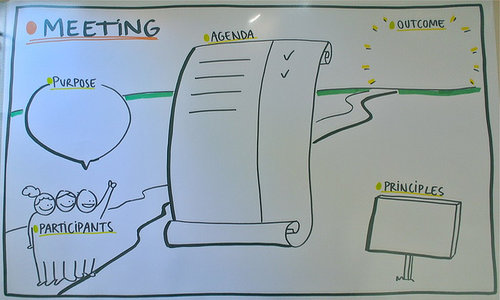Rae Levine, a longtime colleague and friend, with whom I taught meeting management once looked at me in faux disbelief and asked, “Is there anyone left on the planet who does not know how to define desired outcomes for a meeting and build an effective agenda to achieve them?” We both cracked up. It seemed we had been teaching this to multitudes for years.
I still teach both because there are many who either don’t know how to do this or have not experienced the positive impact of doing so. In the past several weeks I taught the basics—purpose and desired outcomes, detailed agendas with clear process steps and time allotments for each step—to over 40 people in two different workshops. The feedback in ensuing sessions was overwhelmingly positive: “Our meeting went so well…We ended early…We got everything done we wanted to get done…It was so great.”
This was music to my ears. Even more interesting were people’s comments on how challenging it was to get clear on what they were trying to accomplish and to identify the process steps to accomplish it. I assured them this would get easier with practice. I also made a case for why taking the time to do so is important: meeting time is expensive financially and emotionally and impacts individual and organizational performance.
Meeting purpose is your overall reason for convening a meeting. For example, “To develop a prioritized list of goals we want to achieve in 2018.” Desired outcomes are the specific, tangible results you intend to accomplish in a meeting in order to reach your purpose. (For information about defining outcomes see “Why Are We Meeting?”)
Here are outcomes that would enable you to reach the purpose noted above:
- Agreement on the most important threats and opportunities in the current business environment;
- Agreement on what is and is not working in our organization;
- Confirmation of the organization’s mission and vision;
- Agreement on criteria with which to evaluate goals for 2018;
- Agreement on list of potential goals for 2018.
Process steps to achieve these outcomes should include some for individual preparation and some for the group during the meeting:
- Reviewing an analysis of the business environment (threats and opportunities in technology, demographics, competitors, customers, suppliers, market trends, global and national economic patterns, governmental regulations) and identifying which ones are most important to the organization’s future success;
- Identifying and prioritizing what’s working and not working in the organization and investigating the causes of the ones having the greatest impact on the organization’s success;
- Revisiting the mission and/or vision of the organization;
- Based on these previous three steps, identifying criteria to evaluate the goals;
- Brainstorming potential goals and evaluating them based on the agreed-upon criteria.
How long would each of these steps take in your meeting? The time needed depends on whether people prepare themselves beforehand and how many people are in the room. Assuming a group of six to eight people, I estimate this meeting would take three to four hours. However, you might want to break this into two meetings, doing the analytical work in the first meeting and projecting into the future at the second. This would allow time for people to individually consider goals for the coming year.
Defining the purpose and outcomes for a meeting enables you to design effective agendas that work, helps people prepare and participate effectively, and positions you to run the meeting and achieve the purpose and desired outcomes. This in turn increases the likelihood that decisions will be sounder and participants will be committed to implementing those decisions.
I realize that for some people this amount of planning and structure can seem rigid or stultifying. My experience is that it is much easier to change an agenda that is clear than it is to achieve something when the purpose and desired outcomes and steps to achieve them are undefined or vague.


Good reminders. Thanks.